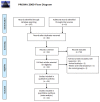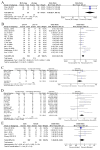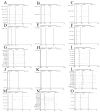CD147 as a novel biomarker for predicting the prognosis and clinicopathological features of bladder cancer: a meta-analysis
- PMID: 28977970
- PMCID: PMC5617530
- DOI: 10.18632/oncotarget.19257
CD147 as a novel biomarker for predicting the prognosis and clinicopathological features of bladder cancer: a meta-analysis
Abstract
Objective: To assess the prognostic and clinicopathological characteristics of CD147 in human bladder cancer.
Methods: Studies on CD147 expression in bladder cancer were retrieved from PubMed, EMBASE, the Cochrane Library, Web of Science, China National Knowledge Infrastructure, and the WanFang databases. Outcomes were pooled with meta-analyzing softwares RevMan 5.3 and STATA 14.0.
Results: Twenty-four studies with 25 datasets demonstrated that CD147 expression was higher in bladder cancer than in non-cancer tissues (OR=43.64, P<0.00001). Moreover, this increase was associated with more advanced clinical stages (OR=73.89, P<0.0001), deeper invasion (OR=3.22, P<0.00001), lower histological differentiation (OR=4.54, P=0.0005), poorer overall survival (univariate analysis, HR=2.63, P<0.00001; multivariate analysis, HR=1.86, P=0.00036), disease specific survival (univariate analysis, HR=1.65, P=0.002), disease recurrence-free survival (univariate analysis, HR=2.78, P=0.001; multivariate analysis, HR=5.51, P=0.017), rate of recurrence (OR=1.91, P=0.0006), invasive depth (pT2∼T4 vs. pTa∼T1; OR=3.22, P<0.00001), and histological differentiation (low versus moderate-to-high; OR=4.54, P=0.0005). No difference was found among disease specific survival in multivariate analysis (P=0.067), lymph node metastasis (P=0.12), and sex (P=0.15).
Conclusion: CD147 could be a biomarker for early diagnosis, treatment, and prognosis of bladder cancer.
Keywords: CD147; bladder cancer; clinicopathological features; meta-analysis; prognosis.
Conflict of interest statement
CONFLICTS OF INTEREST All authors disclosed no relevant relationships.
Figures






Similar articles
-
CD147 as a Novel Prognostic Biomarker for Hepatocellular Carcinoma: A Meta-Analysis.Biomed Res Int. 2017;2017:5019367. doi: 10.1155/2017/5019367. Epub 2017 Mar 12. Biomed Res Int. 2017. PMID: 28386553 Free PMC article. Review.
-
CD147 and glioma: a meta-analysis.J Neurooncol. 2017 Aug;134(1):145-156. doi: 10.1007/s11060-017-2499-4. Epub 2017 May 30. J Neurooncol. 2017. PMID: 28560663 Review.
-
The prognostic and clinicopathologic characteristics of CD147 and esophagus cancer: A meta-analysis.PLoS One. 2017 Jul 11;12(7):e0180271. doi: 10.1371/journal.pone.0180271. eCollection 2017. PLoS One. 2017. PMID: 28700599 Free PMC article.
-
Astrocyte Elevated Gene-1 as a Novel Clinicopathological and Prognostic Biomarker for Gastrointestinal Cancers: A Meta-Analysis with 2999 Patients.PLoS One. 2015 Dec 28;10(12):e0145659. doi: 10.1371/journal.pone.0145659. eCollection 2015. PLoS One. 2015. PMID: 26710214 Free PMC article.
-
Clinicopathological and prognostic significance of nestin expression in patients with breast cancer: a systematic review and meta-analysis.Cancer Cell Int. 2020 May 14;20:169. doi: 10.1186/s12935-020-01252-5. eCollection 2020. Cancer Cell Int. 2020. PMID: 32467665 Free PMC article.
Cited by
-
Targeting cancer-derived extracellular vesicles by combining CD147 inhibition with tissue factor pathway inhibitor for the management of urothelial cancer cells.Cell Commun Signal. 2024 Feb 15;22(1):129. doi: 10.1186/s12964-024-01508-x. Cell Commun Signal. 2024. PMID: 38360687 Free PMC article.
-
CD147 Expression Is Associated with Tumor Proliferation in Bladder Cancer via GSDMD.Biomed Res Int. 2020 Feb 20;2020:7638975. doi: 10.1155/2020/7638975. eCollection 2020. Biomed Res Int. 2020. PMID: 32149134 Free PMC article.
-
Identification of LCA-binding Glycans as a Novel Biomarker for Esophageal Cancer Metastasis using a Lectin Array-based Strategy.J Cancer. 2020 Jun 1;11(16):4736-4745. doi: 10.7150/jca.43806. eCollection 2020. J Cancer. 2020. PMID: 32626520 Free PMC article.
References
-
- May M. Statistics: attacking an epidemic. Nature. 2014;509:S50–S51. - PubMed
-
- Siegel RL, Miller KD, Jemal A. Cancer statistics, 2016. CA Cancer J Clin. 2016;66:7–30. - PubMed
-
- Kaufman DS, Shipley WU, Feldman AS. Bladder cancer. Lancet. 2009;374:239–249. - PubMed
-
- Als AB, Dyrskjot L, von der Maase H, Koed K, Mansilla F, Toldbod HE, Jensen JL, Ulhoi BP, Sengelov L, Jensen KM, Orntoft TF. Emmprin and survivin predict response and survival following cisplatin-containing chemotherapy in patients with advanced bladder cancer. Clin Cancer Res. 2007;13:4407–4414. - PubMed
-
- Shariat SF, Ashfaq R, Karakiewicz PI, Saeedi O, Sagalowsky AI, Lotan Y. Survivin expression is associated with bladder cancer presence, stage, progression, and mortality. Cancer. 2007;109:1106–1113. - PubMed
LinkOut - more resources
Full Text Sources
Other Literature Sources

